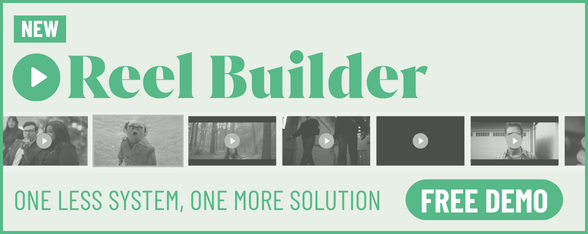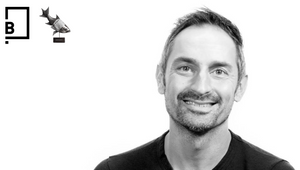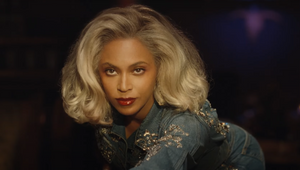
Creativity Squared: Learning from Each Others Perspective with Jeff O’Keefe and Bert Marissen

Jeff O’Keefe and Bert Marissen are creative directors at TBWA Chiat Day LA, where they’ve worked on Blue Diamond Almonds and Behr Paint since the start of 2021.
Jeff is a Chiat veteran whose advertising career includes stops at agencies like Ogilvy, Fallon and Media Arts Lab. His non-advertising career includes a foray into academia, as a writing fellow and lecturer at Stanford. Notable work includes “The City,” for Apple, and “Do The Brave Thing,” a rallying cry to the industry which he wrote for the great Lee Clow, just before his retirement. He likes to ride his bike up mountains, when they’re around.
Bert, originally from the Netherlands, is an ex-competitive gamer who’s worked at agencies around the world, including Crispin Porter Bogusky in Colorado, Happiness in Brussels and Dentsuachtung in Amsterdam. Notable work includes Adobe “Hovering Art Director”, a campaign about the most annoying person in agencies, and the “Volkswagen Stroller”. He’s tall enough to play basketball but, being Dutch, is not good at basketball. So probably don’t ask him to play basketball.
Person
JEFF AND BERT: The most crucial aspect of our dynamic as creative directors is that we’re very different people in general. In terms of upbringing, culture, hobbies, work and life experience – just about everything. Through some weird quirk of the universe, we got along like brothers the moment we met. It helps that we have the utmost respect for each other’s knowledge and perspective and that we’re constantly learning from one another. We’re both curious, detail-oriented and believe that if you’re going to do something, it should be unique and beautifully crafted, no matter how small. Why put more noise into the world?
BERT: People who know me know what they get when they work with me. I’m very direct, opinionated and overall have a no BS policy. Transparency is key. I think it’s because of my Dutch roots – as a people, we are very direct. I’ve carried that across the pond and it has helped me tremendously in the USA. No politics.
I don’t believe that creativity is innate – it’s a skill. And as with any skill, you have to train, again and again, and again, to get better at it. If you do that enough, you’ll get to a point where you don’t have 'off days' anymore. Because I love what I do, I don’t turn off; I’m always thinking about ideas – in the shower, on my balcony in the evening and most definitely in boring meetings. For me there’s nothing as addictive as that gut feeling you get when you land on a great idea or insight. I get especially excited as a creative when it’s something I’ve never heard of. This could be a new mechanic, a quirky insight or a new medium.
JEFF: Any observant writer worth his or her salt is at least a bit introverted, and I’m no exception, but I don’t think of myself as an introvert in a larger sense. I’m a little obsessive about words. I’ve been called 'nice' for as long as I can remember, which is my cross to bear, but also not a horrible way to be described. As far as routine goes, there’s a saying about creative writing, that you need to return to your desk day after day because you never know when the muse will show up. I think that’s very true. But for me, rigor is more important than routine. However you work, just don’t phone it in.
I’m wide open to all the usual creative input, but when I’m in need of a serious creative re-set, I’m drawn to Art with a capital “A,” like a great novel or piece of nonfiction I should have read years ago, or a spin through LACMA or The Broad here in LA. When I lived in New York, it was theatre – nothing is as creatively rejuvenating for me as going to a great play, that infusion of pure art and love of language. I just started watching Season 2 of the sketch comedy show “I Think You Should Leave,” with Tim Robinson. I mention it because, for me, the genius of the show is that it’s continually undermining your expectations. There’s a lesson there that applies to all creative work.
Product
BERT: What makes a piece of work creative? It’s all about the cultural tension of the insight/idea. If you nail that, it will allow you to push the limits of creativity. I’ve never been a fan of traditional campaigns. They’re often very general as a result of their aim to reach mass consumers. A cultural insight allows you to create actions that give life to the idea versus just communicating it. Done right, it’ll engage consumers, making them the engine of your campaign. All the best ideas in the industry do this – the Stevenage Challenge, the Uncensored Library and Michelob Ultra Courtside. Those ideas truly make me jealous.
JEFF: A great creative idea announces itself immediately. There’s a human truth in it, one that feels fresh and undeniable and that aligns with both the purpose of the brand and the cultural moment. There’s always something either provocative or daring about it. There are plenty of obstacles to great creative work in advertising – budget, compressed timelines, lawyers lurking in the perimeter – but when you’re onto something with potential, you know it, and so you protect it and nurture it.
The tricky thing about great ideas is that there’s no guarantee that they’re going to catch fire the way you hope they will. In fact, it’s essential that you don’t know. If you know, you probably played it too safe. It might be challenging to get some colleagues and clients on board with that, but it’s the key to breakthrough work. “You Love Me” for Beats by Dre comes to mind as a stellar example of a provocative, smart, beautiful idea, perfectly aligned to the moment.
It used to be that if you applied the right level of craft and intelligence, combined with the right insight (and a little luck), your work would stand out. Today, the bar is much higher. Work needs to do much more. It needs to make a dent in culture. That challenge is both daunting and exciting.
Process
JEFF AND BERT: We believe in working with a flat structure. By which we mean: small teams, where every person has a clear role and responsibility. With rare exceptions, we don’t hold creative-only reviews. As creatives, over our careers, we’ve both been involved in projects that stayed creative-only for a few rounds and then just fell apart once other departments joined the party, wasting weeks of precious time. Once they were brought in, account, strategy and others felt that the work was being foisted on them, rather than feeling it was also theirs. And they weren’t wrong. Advertising is all about collaboration.
Now, every team member is involved from the get-go and valued for the perspective they bring. Non-creatives respect the delicate process underway between creatives, but they’re also empowered to help steer and shape the project. And if a client happens to call an account manager, for example, that account manager has a deep understanding of the ideas on the table and is able to advocate for them. In the end, we get to a good point much faster. And nowadays, speed is the name of the game. Trends come and go, and to respond, you need to be able to move quickly.
Press
BERT: I’ve lived in many different cities around the world – Willemstad, London, Brussels, Amsterdam, Denver and Los Angeles – and I’ve worked in advertising in each of them, at both big and small agencies. This experience exposed me to many different ways of working and allowed me to explore what works best for me.
When I was 15, I was a competitive Halo player. In Halo, you’re part of a team of four. You have to communicate clearly and quickly to spot the enemy. It may sound funny, but I still use this communication style with my agency teammates -- clear, direct and transparent. I just cut the screaming part.
I’m originally from the Netherlands. People work more efficiently there because budgets are much smaller. A 'hustle' mentality is required to make things happen. When I came to America five years ago, I noticed that budgets were much more significant and therefore, timelines were longer. More people were involved and they all wanted a piece of the pie. This is the biggest struggle I’ve faced here in America. But I still have that hustle mentality, and I genuinely believe it’s what allows me to create fast.
I’ve only worked at agencies that valued experiential ideas, both in Europe and in America. Experiential ideas are awesome but very hard to sell and even harder to keep alive. A traditional campaign gets presented and sold and goes into production. An experiential idea can die at so many points in the process because you’re often (if you’re doing your job right) attempting something that’s never done before. For one client, we deployed a blimp to a music festival to allow people to party in the shade -- it almost died because of an unforeseen thunderstorm. This summer, an Olympic medal-biting activation almost died because the athletes were being required to wear masks at the medal ceremony. You have to be ready to pivot and come up with solutions on the spot, before people lose faith in the idea. But when you pull it off, it feels truly amazing. You have to be scrappy and figure things out on the go.
My advice to clients: ground breaking ideas require a bit of faith that things will get figured out while they’re being made. You won’t see the final product on a slide in a deck. A leap of faith allows you to start prototyping much faster and that’s where you’ll know if you thought about everything. Don’t wait – start making things happen.
JEFF: I grew up in Oregon until I was 14 and then we moved to the suburbs of Hartford, Connecticut. Though most of my family is in New England, I still feel like an Oregonian deep down. I don’t know if it’s that I was drawn to artistic pursuits early or just that I was so deeply bad at math and science that I figured, “Oh, I must be creative.” I’m only half kidding. The fact that a few extended family members made their living creatively made a big impression on me, showing me that this was a path you could follow.
In high school, some friends and I asked our Modern European History teacher if we could make a film together instead of turning in the final paper, and she said yes. We spent hours in a basement making this thing – using props, acting out parts, finding fun, inventive ways to represent the historical events we’d covered in class. Then we edited it, wrote and recorded narration, and so on. It was a lot of work, and we ended up getting a B-minus. I remember thinking, okay, society may not always reward you for making creative choices, but I’m not sure how much I care, because that was fun.
Around then I discovered that my creativity blossomed under pressure. This was definitely the case in college, when I developed the horrible habit of procrastinating until the last moment and then pulling all-nighters to write papers. But it worked – ideas seemed to unlock themselves as the clock ticked down – so I kept doing it. I kept doing it during my hiatus from advertising, when I was getting an MFA in Creative Writing in Arizona, and beyond. I still find that the pressure of a looming deadline brings things into focus.
A piece of advice for creatives in terms of honing your craft: keep an open mind at every stage of the process – if you’re too rigid or protective of your work you’ll miss out on the opportunity to sharpen and improve it. Trust your gut, but value input – measure it, give it its due. Allow the universe to help you make the work better, whether that work is one sentence or a big, complex activation.
And a reminder to clients: you should want to be challenged. You should want your instincts to be respectfully interrogated. That’s part of any good agency’s duty to you. Sometimes, on both the client and agency side, we get so caught up in day-to-day operations that we lose track of our shared motivation: to make your brand famous, to lift it above the noise. If we’re not vigilant, our instincts can place us right there, squarely in the noise.















